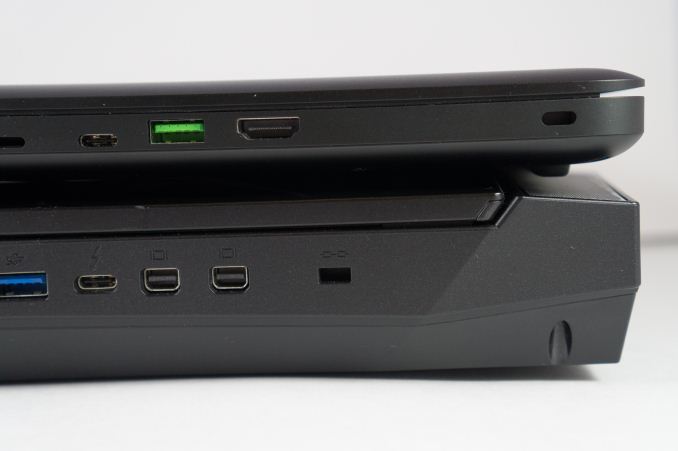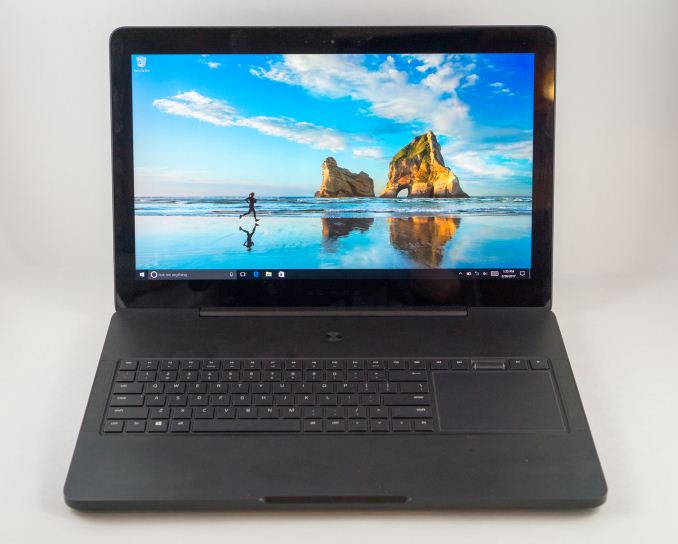The 2016 Razer Blade Pro Review
by Brandon Chester on March 6, 2017 8:00 AM EST- Posted in
- Laptops
- Razer
- Razer Blade Pro
Final Words
With the 2016 Blade Pro, Razer's goal has been to create the most powerful gaming machine possible in a form factor that is much smaller and lighter than your typical desktop replacement machine. That being said, the Blade Pro is not the kind of laptop that you'll throw in a backpack and carry around for the entire day, and despite its designation, it's not really something you'll want to use on your lap. With a mass of 3.54kg, and a large 17.3" display, it's more like a highly portable computer than a notebook.
The Razer Blade Pro is one of the most well-constructed laptops that I've used. The chassis is incredibly solid, and designing it out of a single block of aluminum allows for an enclosure without visible seams. I find the black finish quite striking as well, and it really stands out among a sea of grey plastic laptops.
The design of the laptop is a mixed bag for me. I think the keyboard and trackpad layout is interesting, and the ergonomics of it are actually quite nice. There are also some interesting design accents like the raised portions on the left and right side of the top cover. I also find some aspects of the design to be distasteful, such as the green glowing Razer logo on the back, the keyboard key font, the green accents on the USB ports, and the Chroma backlighting, although admittedly that last one can be turned off or toned down to a simple static white color. I would love a version with a totally black finish, complete with a black razer logo without the LEDs, but I understand that the green and black color scheme is closely tied with Razer's brand.
The general performance of the Blade Pro is in line with existing Core i7-6700HQ machines. I don't mean to keep bringing up the same point over and over, but with the Blade Pro being a very expensive premium machine, Razer really should have used the Core i7-6920HQ to give themselves an edge over the competition. While the Blade Pro is vastly more portable than DTR machines like the Clevo P870DM2, it still has to compete with them in the eyes of consumers, and those machines are thick and large enough to accomodate Intel's desktop CPUs. Using the Core i7-6920HQ would have helped to close the gap, and made the Blade Pro's general performance even more impressive.
Razer Blade Pro on top of a Clevo DTR
As for GPU-bound workloads, there's very few other laptops that can compete with the Blade Pro. Unless you're willing to go with a DTR, which will be twice as thick and nearly twice as heavy, the Blade Pro is the fastest laptop you'll find. Much of the gap in gaming performance actually comes from the difference in CPUs, and during my testing I observed essentially no throttling of the GPU clocks even with a long-running workload. This is a really impressive feat on the part of Razer and NVIDIA. I still find it amazing that a laptop the size of the Blade Pro greatly surpasses the performance of desktop computers with NVIDIA's GTX 980, which was the flagship card of the Maxwell generation. We've certainly come a long way from the days where the best laptop GPUs were basically equivalent to the mid-range desktop parts, and the Blade Pro is perhaps the ultimate demonstration of how far we've come.
The Blade Pro's display is not as good as I expected it to be, and it really kills the possibility of using the Blade Pro as a mobile workstation for anyone who does color-critical work. Targeting Adobe RGB without an sRGB color mode under Windows is just unacceptable, end of story. However, even if Windows did have end-to-end color management throughout all its frameworks and applications, that wouldn't change the fact that the calibration relative to Adobe RGB is not very good either. To do any sort of color-critical work, even in a color-managed application, you need to completely redo the display calibration. Fixing these problems would elevate the Blade Pro from a gaming machine to an incredible portable workstation for video editing and visual design, and it wouldn't even be very difficult. We're now living in a world where you can get perfectly calibrated displays in $600 tablets, so there's no excuse for a $3699 laptop to suffer from these issues.
As for battery life, I would say it's perfectly acceptable and actually more than I expected. Razer cannot wish away the realities of the world. A machine with this performance is going to consume a given amount of power even when it's not doing much, and the only potential optimization would be to get rid of G-SYNC so Optimus could be used, but with the goal of a gaming laptop in mind that would be a detrimental product change overall. I will say that using two separate SSDs has a power cost, although I don't think it's of much significance compared to the CPU, GPU, and display. Razer is also stuck with the battery capacity of 99Wh, unless they want to sell a laptop that you can't bring on an airplane. I would love to have a thin gaming laptop that manages to last ten hours on its battery at max performance, but as far as realistic expectations go, close to four hours of battery life for general tasks at 200 nits is quite good for a 17-inch gaming laptop.
The 2016 Razer Blade Pro is a great gaming laptop. I certainly wish I could afford one for myself. My life right now is characterized by frequent moving due to work and university, and something like the Blade Pro would allow me to bring an incredibly powerful machine with me wherever I go. While the Blade Pro fulfills its role as a high performance gaming machine, it did let me down as a mobile workstation. The issues with the display calibration and lack of an sRGB color mode make it unusable for much of the work I do. On top of that, product decisions like using two SSDs in RAID0, using Intel's slowest Core i7 H series quad core part, and using Killer's networking chips just don't make sense. With the SSDs and the networking, Razer is paying more money for a worse outcome just because it's marketable to gamers, but with the CPU they didn't spend the extra money on something that would have a real impact on performance. This isn't just a difference of opinion on what makes a good product; the choices that were made are objectively and demonstrably worse than the alternative.
In the end, the Razer Blade Pro is a powerful, portable gaming machine, but I feel that it has so much potential that can't be unlocked because of a few questionable product decisions. Most of the issues I've highlighted would be really easy to address, and it would allow the Blade Pro to be so much more than just a gaming laptop. I really like the Razer Blade Pro, and I really want one. Unfortunately, if I'm spending that much money on a laptop, I need it to truly be a no-compromises machine. As someone who needs a computer for more than playing games, it just doesn't hit that mark.













57 Comments
View All Comments
fanofanand - Monday, March 6, 2017 - link
I bought my wife a cheap $350 Acer (because she doesn't know the difference) and despite her repeated attempts, she has been unable to destroy it. Plastic is not premium, but is great when you are building things to a price point. Most consumer electronics sold are not the top-end gear.BrokenCrayons - Monday, March 6, 2017 - link
I think the part I don't like about plastic laptops are those metal-in-plastic screw fittings where there's a little threaded cylinder for the screw that has that knotty outside and get stuffed into a hollow plastic tube. (No idea what the technical name for those things are.) The plastic sometimes will crack around them and the screws along with the threaded cylinder thingies will break free.Barilla - Monday, March 6, 2017 - link
Ok, just to clarify - I have no issue with this laptop being made of aluminium, I even agree it's a good choice, although if I wanted to be picky, there are carbon fibre materials with thermal conductivity equal to or higher than aluminium.I meant it on a more general level as your comment about carbon fibre mentioned Dell XPS, which in it's 13" version houses a 15W CPU and no dGPU, which means it needs to dissipate at most 1/10th the heat this laptop does.
Really, nothing against aluminium. Or magnesium either, as I'm typing this comment from a Surface. All I'm saying is that plastic, and especially carbon fibre, is a perfectly fine material in many - not all - applications, including some laptop and smartphone chassis.
Peace.
Azurael - Monday, March 6, 2017 - link
I wonder whether people will ever get beyond that 'it looks more premium' mindset with CFRP (or even polycarb) vs. metals. Personally, I'd prefer to be able to buy 'plastic' versions of any portable electronics for impact resistance, metal devices are far too easy to dent and break. It's all very well having a metal phone or laptop, but if you have to keep it in a plastic/rubber case all the time to keep it safe, I don't see the point.simonm - Monday, March 6, 2017 - link
Carbon fibre is strong but to the best of my knowledge not usually a good conductor of heat except for certain specialised versions.So unless Razer went with some kind of super carbon fibre the case won't be able to facilitate cooling (like an extended heat sink) as well as if it were aluminium. I doubt Razer did use a high conductivity fibre or they'd be marketing the hell out of that.
Instead they chose it probably for its high strength/rigidity to weight ratio, lower cost than aluminium and marketing because it sounds cool and high end.
If money (and weight) wasn't an option you could use lots of metal alloys that are more conductive than aluminium. Copper... gold ;)
simonm - Monday, March 6, 2017 - link
Correction: change option to issue!PS: So I think most people are looking down on the CF for its thermal properties when compared with aluminium. Aluminium offers good weight and thermal properties but with high expense and lower hardness/rigidity than carbon fibre.
With a 1080 packed in there and a 180 W power adapter I reckon you'd want as much help dissipating heat as you can get. So carbon fibre seems like something of a compromise.
colonelclaw - Monday, March 6, 2017 - link
Surely carbon fibre is much more expensive than aluminium? That's the impression I always got from products that use it, or is that just marketing?fanofanand - Monday, March 6, 2017 - link
Carbon Fiber (the high-tech variety) is far more expensive than aluminum.Bullwinkle J Moose - Monday, March 6, 2017 - link
if money (and weight) wasn't an option.....Diamond plated Silver would be a far better thermal conductor than Copper or Gold
Diamond has 3X the thermal conductivity of even silver
But a diamond frost coat on copper would look better
A Rose Gold that costs as much as real Gold
Sound like an Apple Product!
SkipPerk - Wednesday, April 19, 2017 - link
In order to plate the silver to make it strong enough I think it would interfere with the thermal transfer. I think nickel-plated copper would be the better choice, although it would still be soft. Aluminum really is the best choice.